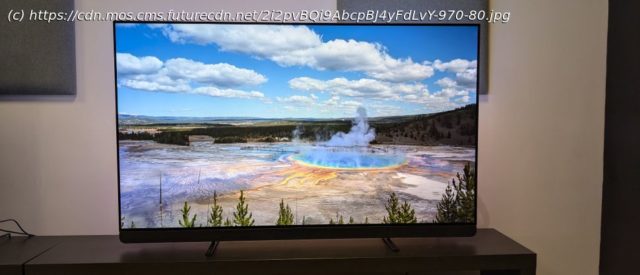Another stunning OLED TV from Philips
Philips OLED909 review: Two minute review
The Philips OLED909 covers pretty much every base, whether it’s picture, sound, gaming or design, and easily inserts itself into the running for the best TVs of the year. It may be pricier than some of the other best OLED TVs, but it’s a top-notch performer with plenty to like.
Picture quality is nothing short of spectacular on the Philips OLED909. Vibrant, accurate colours mix with superb contrast and deep black levels to create a well-balanced picture. Details and textures are lifelike and its motion handling is very good. It may not have the upscaling chops of the LG G4 or the same level of detail as the Samsung S95D, but the OLED909’s picture is dynamic, punchy and just downright stunning.
While some TVs have unimpressive built-in sound, the OLED909 easily competes with the best TVs for sound, such as the Sony Bravia 8. With a Bowers & Wilkins speaker system that provides real power, accuracy and plenty of immersion, you might not have to invest in one of the best soundbars. Dolby Atmos effects are a little lacking, but bass, dialogue clarity, and sound effects placement are all brilliant.
Ambilight, a Philips tech that projects coloured lights onto the wall behind the TV, gives the OLED909 an even greater sense of immersion than other TVs, especially when viewed in darker lighting conditions. The OLED909 feels every bit premium. The swivelling central stand found on the step-down Philips OLED809 is more useful than the OLED909’s metal feet, but that’s my only real complaint about this otherwise beautifully designed TV.
Google TV serves as a solid, functional smart TV platform, but it’s a shame there’s no access to Freeview Play and its associated apps such as BBC iPlayer, ITVX, and . (Pick up an Amazon Fire Stick or other streaming device to solve this issue.) But, there are plenty of picture and sound settings for people to experiment with, and navigation is user-friendly enough.
The OLED909 comes equipped with an excellent stock of what we look for in the best gaming TVs, including 4K 144Hz, Dolby Vision gaming, and VRR (in multiple formats). It only comes with two HDMI 2.1 ports, however, but this is one of the few downsides of an otherwise superb gaming TV with picture quality and performance to match its features.
The OLED909 undoubtedly sits at the pricier end of the TV market, with the 55-inch model I tested retailing for £1,999. This is significantly more expensive than mid-range OLEDs such as the LG C4 and even slightly more expensive than flagship OLEDs such as the Samsung S95D. But, the OLED909 offers a premium experience, so expect to pay the higher price that comes with that.Philips OLED909 review: Prices & release date
Release date: August 2024
55-inch: £1,999
65-inch: £2,499
77-inch: £4,499
The Philips OLED909 is the upper mid-range OLED series in Philips’ 2024 TV lineup, sitting above the OLED809 and OLED759 and below the flagship OLED+959. It is available in 55-, 65- and 77-inch sizes.
For the 55-inch model I tested, you’ll be looking to pay £1,999, which is pricier than both the flagship Samsung S95D and LG G4 OLED models, both of which are priced at roughly £1,799. Since its release, prices haven’t dropped as it’s only been around for a number of weeks, so we could see some discounts in the future.Philips OLED909 review: SpecsPhilips OLED909 review: Benchmark results Philips OLED909 review: Features
2nd Generation Micro Lens Array (MLA) OLED panel
Four-sided Ambilight
Bowers & Wilkins 3.1-channel speaker array
The OLED909 is equipped with a second-generation MLA OLED panel – the same you’ll find in the LG G4 and the step-up Philips OLED959. This provides a brightness boost over both standard W-OLED models, such as the LG B4, and even OLED EX models, such as the LG C4 and the OLED909’s step-down sibling, the Philips OLED809.
The OLED909 supports both the Dolby Vision and HDR10+ high dynamic range formats. It also supports IMAX Enhanced content and has a picture mode compatible with Portrait Displays’ Calman colour calibration software for those who expect to have their TV professionally calibrated.
As with many Philips TVs, a prominent feature is Ambilight tech, which projects coloured lights onto a wall behind the TV. Ambilight can be customised in different ways, such as following the video or audio or displaying a single colour to create a mood. The OLED909 features the full four-sided version of Ambilight, with an extra strip at the bottom of the rear panel, as opposed to the three-sided Ambilight version found on the OLED809 and other step-down Philips TVs.
For audio, the OLED909 features a 3.1-channel speaker array made by Bowers & Wilkins, totalling 80W of power. Both Dolby Atmos and DTS:X audio formats are supported and it features an AI Sound mode, Dolby Bass Enhancement, Night Mode and Room Calibration.
Gaming is well covered on the OLED909, with support for 4K 144Hz, Dolby Vision gaming, VRR (including AMD FreeSync Premium and Nvidia G-Sync), HGiG and ALLM. There is also a new game bar that can be used to adjust gaming settings and even save customised profiles for each game or console. Like other current TVs not made by LG or Samsung, the OLED909 only features two HDMI 2.1 ports and not the full four favoured by gamers.
The OLED909 uses Google TV as its smart TV platform, with access to popular streaming apps such as Netflix, Prime Video, Disney Plus and more. There is no support for UK-based apps such as BBC iPlayer, ITVX and , or Freeview Play and other associated apps, however.
Features score: 4.5/5Philips OLED909 review: Picture quality
Stunning, accurate colours
Rich contrast
Lifelike detail and textures
The OLED909’s second-generation MLA OLED panel yielded peak brightness results of 1,403 and 1,265 nits in Standard and Filmmaker Mode respectively when measured using a 10% HDR white window pattern. This is roughly 30% brighter than the step-down OLED809, which yielded results of 1,088 and 927 nits on the same tests. The LG G4, which uses the same panel, achieved a higher peak brightness in Filmmaker Mode, hitting 1,489 nits.
Full-screen brightness measured on a 100% HDR white window pattern was 264 and 249 nits in Standard and Filmmaker Modes respectively, which is only marginally lower than the LG G4’s 259 nits Filmmaker Mode result. The Samsung S95D, which uses a QD-OLED panel, achieved a result of 318 nits on this same test. Note that these full-screen numbers pale in comparison to the best mini-LED TVs, which easily achieve over 500 nits – a factor due to the automatic brightness-limiting controls used by OLED TVs to protect the display panel.
Starting with lower-resolution TV shows to evaluate the OLED909’s upscaling, textures were on the fuzzy side, but it was a marginal improvement over the Philips OLED809 when I tested it.
Home
United States
USA — software Philips OLED909 review: a superb OLED TV with a great feature LG...






